Taxation Law Assignment - Income, Fringe Benefits, and CGT Analysis
VerifiedAdded on 2021/06/17
|6
|1596
|50
Homework Assignment
AI Summary
This document provides a comprehensive analysis of a tax law assignment. The assignment addresses several key areas of taxation, including the tax treatment of income from personal exertion, as exemplified by a mountain climber receiving payments for an autobiography, manuscript, and photographs. It also delves into the calculation of taxable value for car fringe benefits using the statutory formula, considering base value, statutory percentage, and utilization days. Furthermore, the assignment examines the tax implications of a financial transaction involving a loan from a parent to a son, including the treatment of interest and the classification of the repayment as either ordinary income or a gift. Finally, the document analyzes capital gains tax (CGT) implications arising from the sale of a property, considering scenarios involving pre-CGT land acquisition, the application of indexation and discount methods, and the impact of changes in market value and company ownership on the calculation of taxable capital gains. References to relevant legislation and case law are included to support the analysis.
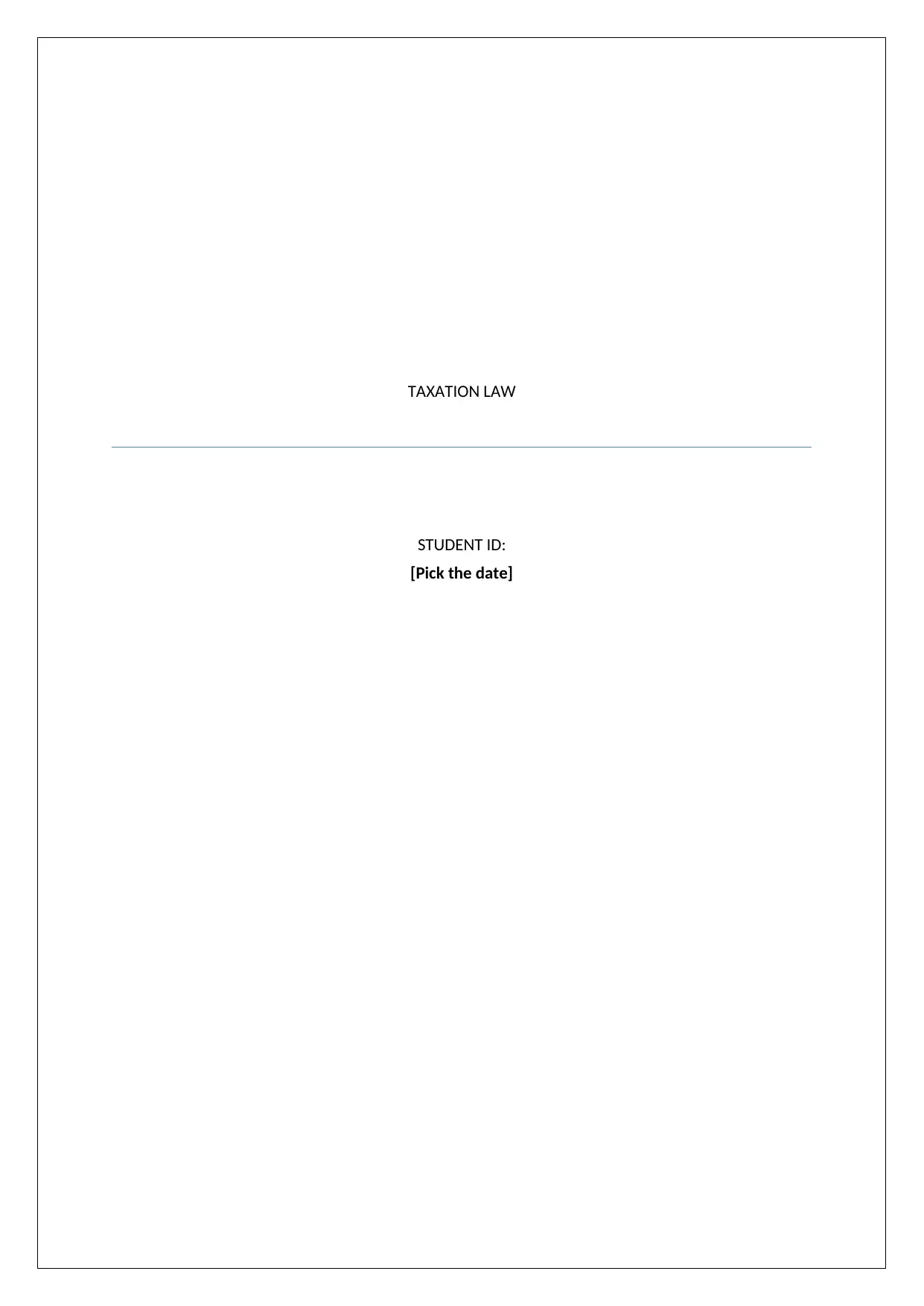
TAXATION LAW
STUDENT ID:
[Pick the date]
STUDENT ID:
[Pick the date]
Paraphrase This Document
Need a fresh take? Get an instant paraphrase of this document with our AI Paraphraser
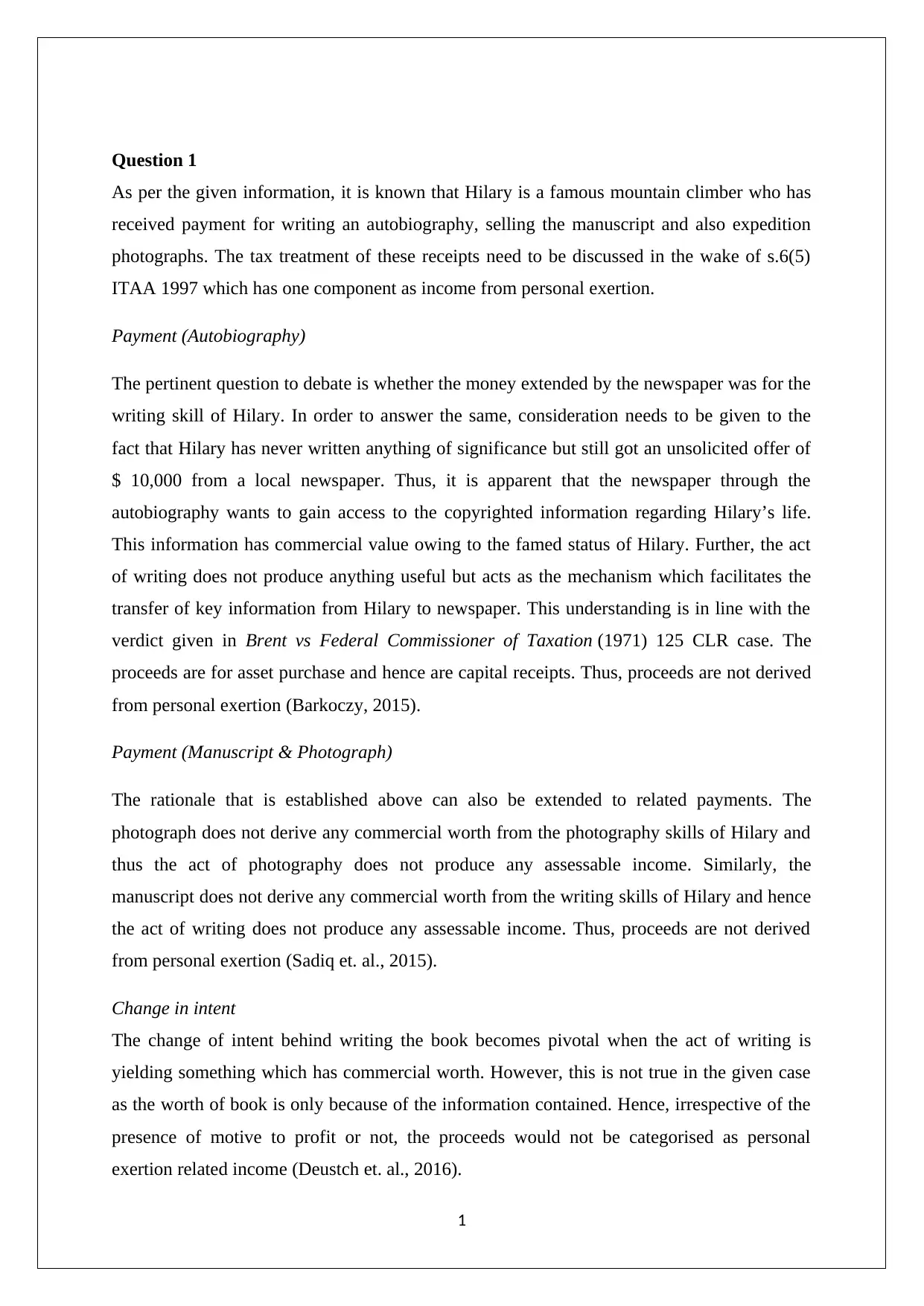
Question 1
As per the given information, it is known that Hilary is a famous mountain climber who has
received payment for writing an autobiography, selling the manuscript and also expedition
photographs. The tax treatment of these receipts need to be discussed in the wake of s.6(5)
ITAA 1997 which has one component as income from personal exertion.
Payment (Autobiography)
The pertinent question to debate is whether the money extended by the newspaper was for the
writing skill of Hilary. In order to answer the same, consideration needs to be given to the
fact that Hilary has never written anything of significance but still got an unsolicited offer of
$ 10,000 from a local newspaper. Thus, it is apparent that the newspaper through the
autobiography wants to gain access to the copyrighted information regarding Hilary’s life.
This information has commercial value owing to the famed status of Hilary. Further, the act
of writing does not produce anything useful but acts as the mechanism which facilitates the
transfer of key information from Hilary to newspaper. This understanding is in line with the
verdict given in Brent vs Federal Commissioner of Taxation (1971) 125 CLR case. The
proceeds are for asset purchase and hence are capital receipts. Thus, proceeds are not derived
from personal exertion (Barkoczy, 2015).
Payment (Manuscript & Photograph)
The rationale that is established above can also be extended to related payments. The
photograph does not derive any commercial worth from the photography skills of Hilary and
thus the act of photography does not produce any assessable income. Similarly, the
manuscript does not derive any commercial worth from the writing skills of Hilary and hence
the act of writing does not produce any assessable income. Thus, proceeds are not derived
from personal exertion (Sadiq et. al., 2015).
Change in intent
The change of intent behind writing the book becomes pivotal when the act of writing is
yielding something which has commercial worth. However, this is not true in the given case
as the worth of book is only because of the information contained. Hence, irrespective of the
presence of motive to profit or not, the proceeds would not be categorised as personal
exertion related income (Deustch et. al., 2016).
1
As per the given information, it is known that Hilary is a famous mountain climber who has
received payment for writing an autobiography, selling the manuscript and also expedition
photographs. The tax treatment of these receipts need to be discussed in the wake of s.6(5)
ITAA 1997 which has one component as income from personal exertion.
Payment (Autobiography)
The pertinent question to debate is whether the money extended by the newspaper was for the
writing skill of Hilary. In order to answer the same, consideration needs to be given to the
fact that Hilary has never written anything of significance but still got an unsolicited offer of
$ 10,000 from a local newspaper. Thus, it is apparent that the newspaper through the
autobiography wants to gain access to the copyrighted information regarding Hilary’s life.
This information has commercial value owing to the famed status of Hilary. Further, the act
of writing does not produce anything useful but acts as the mechanism which facilitates the
transfer of key information from Hilary to newspaper. This understanding is in line with the
verdict given in Brent vs Federal Commissioner of Taxation (1971) 125 CLR case. The
proceeds are for asset purchase and hence are capital receipts. Thus, proceeds are not derived
from personal exertion (Barkoczy, 2015).
Payment (Manuscript & Photograph)
The rationale that is established above can also be extended to related payments. The
photograph does not derive any commercial worth from the photography skills of Hilary and
thus the act of photography does not produce any assessable income. Similarly, the
manuscript does not derive any commercial worth from the writing skills of Hilary and hence
the act of writing does not produce any assessable income. Thus, proceeds are not derived
from personal exertion (Sadiq et. al., 2015).
Change in intent
The change of intent behind writing the book becomes pivotal when the act of writing is
yielding something which has commercial worth. However, this is not true in the given case
as the worth of book is only because of the information contained. Hence, irrespective of the
presence of motive to profit or not, the proceeds would not be categorised as personal
exertion related income (Deustch et. al., 2016).
1
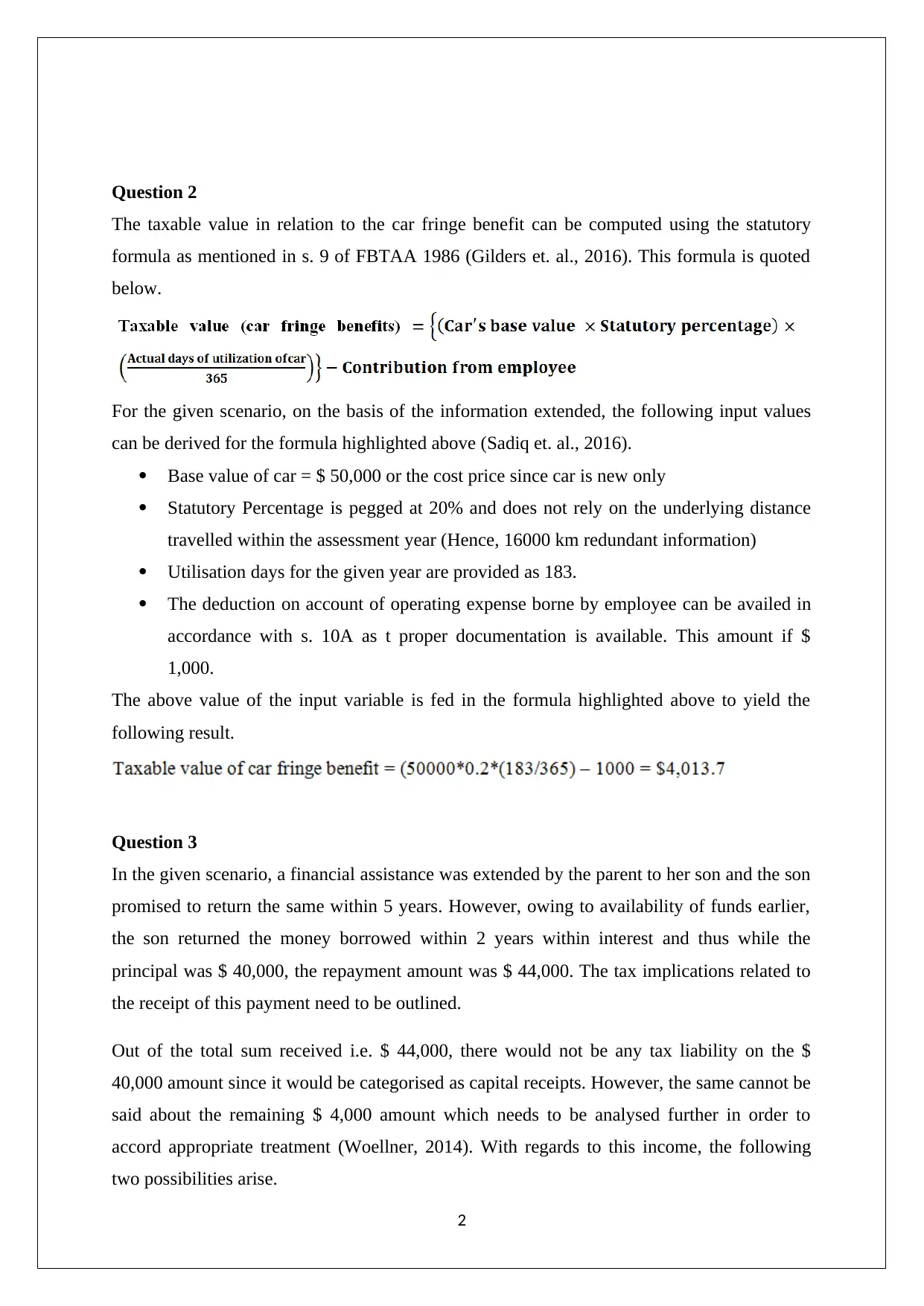
Question 2
The taxable value in relation to the car fringe benefit can be computed using the statutory
formula as mentioned in s. 9 of FBTAA 1986 (Gilders et. al., 2016). This formula is quoted
below.
For the given scenario, on the basis of the information extended, the following input values
can be derived for the formula highlighted above (Sadiq et. al., 2016).
Base value of car = $ 50,000 or the cost price since car is new only
Statutory Percentage is pegged at 20% and does not rely on the underlying distance
travelled within the assessment year (Hence, 16000 km redundant information)
Utilisation days for the given year are provided as 183.
The deduction on account of operating expense borne by employee can be availed in
accordance with s. 10A as t proper documentation is available. This amount if $
1,000.
The above value of the input variable is fed in the formula highlighted above to yield the
following result.
Question 3
In the given scenario, a financial assistance was extended by the parent to her son and the son
promised to return the same within 5 years. However, owing to availability of funds earlier,
the son returned the money borrowed within 2 years within interest and thus while the
principal was $ 40,000, the repayment amount was $ 44,000. The tax implications related to
the receipt of this payment need to be outlined.
Out of the total sum received i.e. $ 44,000, there would not be any tax liability on the $
40,000 amount since it would be categorised as capital receipts. However, the same cannot be
said about the remaining $ 4,000 amount which needs to be analysed further in order to
accord appropriate treatment (Woellner, 2014). With regards to this income, the following
two possibilities arise.
2
The taxable value in relation to the car fringe benefit can be computed using the statutory
formula as mentioned in s. 9 of FBTAA 1986 (Gilders et. al., 2016). This formula is quoted
below.
For the given scenario, on the basis of the information extended, the following input values
can be derived for the formula highlighted above (Sadiq et. al., 2016).
Base value of car = $ 50,000 or the cost price since car is new only
Statutory Percentage is pegged at 20% and does not rely on the underlying distance
travelled within the assessment year (Hence, 16000 km redundant information)
Utilisation days for the given year are provided as 183.
The deduction on account of operating expense borne by employee can be availed in
accordance with s. 10A as t proper documentation is available. This amount if $
1,000.
The above value of the input variable is fed in the formula highlighted above to yield the
following result.
Question 3
In the given scenario, a financial assistance was extended by the parent to her son and the son
promised to return the same within 5 years. However, owing to availability of funds earlier,
the son returned the money borrowed within 2 years within interest and thus while the
principal was $ 40,000, the repayment amount was $ 44,000. The tax implications related to
the receipt of this payment need to be outlined.
Out of the total sum received i.e. $ 44,000, there would not be any tax liability on the $
40,000 amount since it would be categorised as capital receipts. However, the same cannot be
said about the remaining $ 4,000 amount which needs to be analysed further in order to
accord appropriate treatment (Woellner, 2014). With regards to this income, the following
two possibilities arise.
2
⊘ This is a preview!⊘
Do you want full access?
Subscribe today to unlock all pages.

Trusted by 1+ million students worldwide
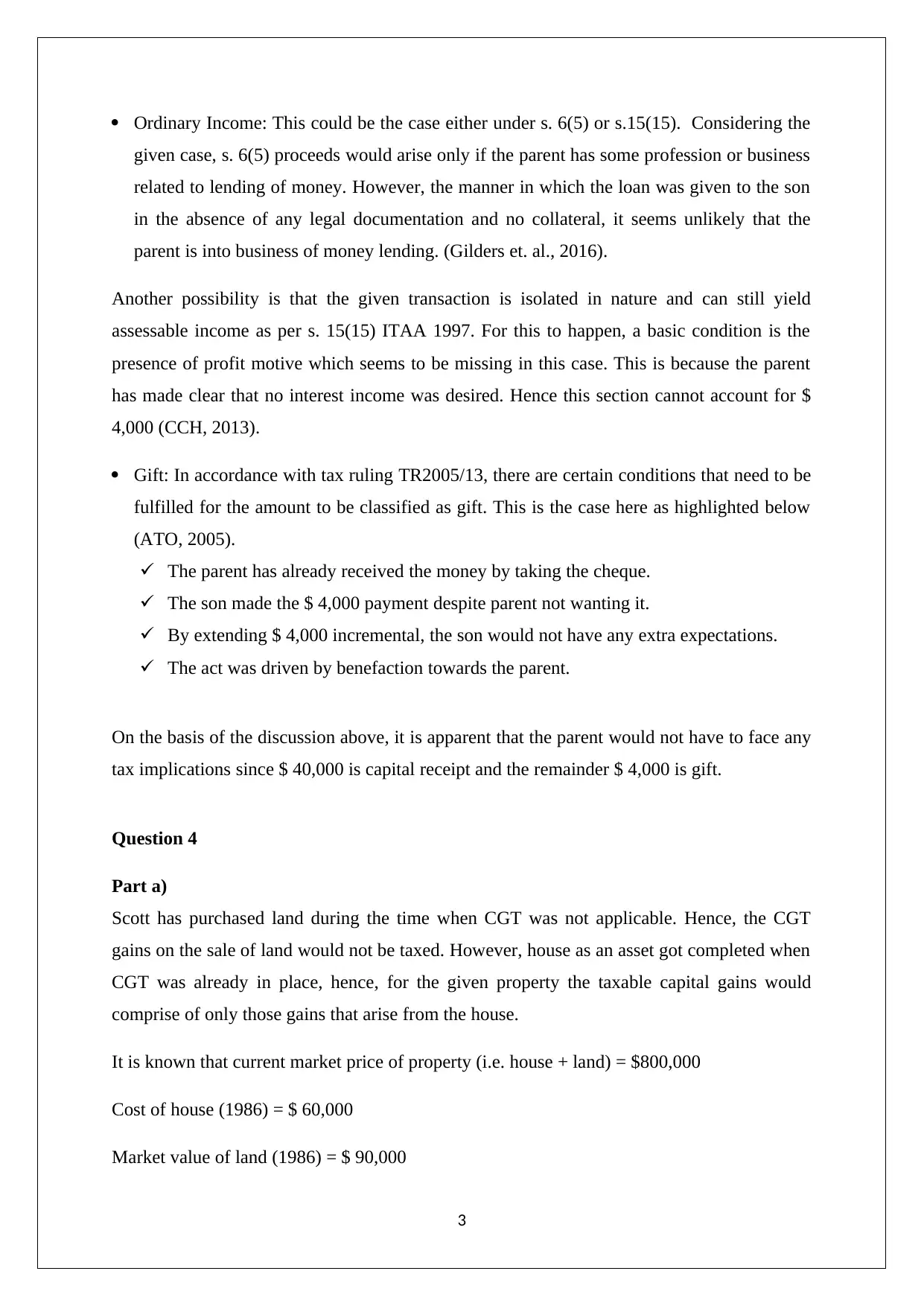
Ordinary Income: This could be the case either under s. 6(5) or s.15(15). Considering the
given case, s. 6(5) proceeds would arise only if the parent has some profession or business
related to lending of money. However, the manner in which the loan was given to the son
in the absence of any legal documentation and no collateral, it seems unlikely that the
parent is into business of money lending. (Gilders et. al., 2016).
Another possibility is that the given transaction is isolated in nature and can still yield
assessable income as per s. 15(15) ITAA 1997. For this to happen, a basic condition is the
presence of profit motive which seems to be missing in this case. This is because the parent
has made clear that no interest income was desired. Hence this section cannot account for $
4,000 (CCH, 2013).
Gift: In accordance with tax ruling TR2005/13, there are certain conditions that need to be
fulfilled for the amount to be classified as gift. This is the case here as highlighted below
(ATO, 2005).
The parent has already received the money by taking the cheque.
The son made the $ 4,000 payment despite parent not wanting it.
By extending $ 4,000 incremental, the son would not have any extra expectations.
The act was driven by benefaction towards the parent.
On the basis of the discussion above, it is apparent that the parent would not have to face any
tax implications since $ 40,000 is capital receipt and the remainder $ 4,000 is gift.
Question 4
Part a)
Scott has purchased land during the time when CGT was not applicable. Hence, the CGT
gains on the sale of land would not be taxed. However, house as an asset got completed when
CGT was already in place, hence, for the given property the taxable capital gains would
comprise of only those gains that arise from the house.
It is known that current market price of property (i.e. house + land) = $800,000
Cost of house (1986) = $ 60,000
Market value of land (1986) = $ 90,000
3
given case, s. 6(5) proceeds would arise only if the parent has some profession or business
related to lending of money. However, the manner in which the loan was given to the son
in the absence of any legal documentation and no collateral, it seems unlikely that the
parent is into business of money lending. (Gilders et. al., 2016).
Another possibility is that the given transaction is isolated in nature and can still yield
assessable income as per s. 15(15) ITAA 1997. For this to happen, a basic condition is the
presence of profit motive which seems to be missing in this case. This is because the parent
has made clear that no interest income was desired. Hence this section cannot account for $
4,000 (CCH, 2013).
Gift: In accordance with tax ruling TR2005/13, there are certain conditions that need to be
fulfilled for the amount to be classified as gift. This is the case here as highlighted below
(ATO, 2005).
The parent has already received the money by taking the cheque.
The son made the $ 4,000 payment despite parent not wanting it.
By extending $ 4,000 incremental, the son would not have any extra expectations.
The act was driven by benefaction towards the parent.
On the basis of the discussion above, it is apparent that the parent would not have to face any
tax implications since $ 40,000 is capital receipt and the remainder $ 4,000 is gift.
Question 4
Part a)
Scott has purchased land during the time when CGT was not applicable. Hence, the CGT
gains on the sale of land would not be taxed. However, house as an asset got completed when
CGT was already in place, hence, for the given property the taxable capital gains would
comprise of only those gains that arise from the house.
It is known that current market price of property (i.e. house + land) = $800,000
Cost of house (1986) = $ 60,000
Market value of land (1986) = $ 90,000
3
Paraphrase This Document
Need a fresh take? Get an instant paraphrase of this document with our AI Paraphraser
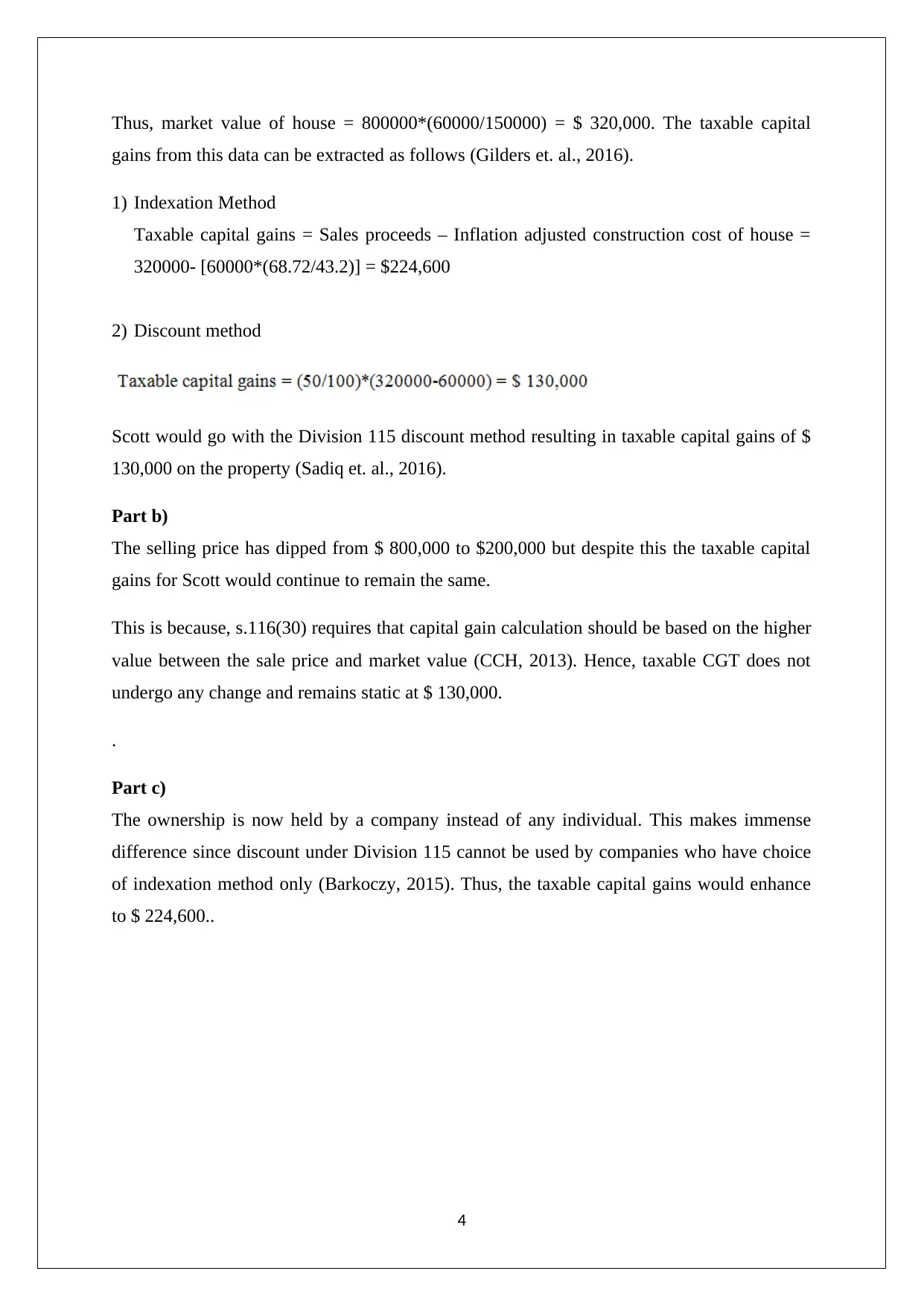
Thus, market value of house = 800000*(60000/150000) = $ 320,000. The taxable capital
gains from this data can be extracted as follows (Gilders et. al., 2016).
1) Indexation Method
Taxable capital gains = Sales proceeds – Inflation adjusted construction cost of house =
320000- [60000*(68.72/43.2)] = $224,600
2) Discount method
Scott would go with the Division 115 discount method resulting in taxable capital gains of $
130,000 on the property (Sadiq et. al., 2016).
Part b)
The selling price has dipped from $ 800,000 to $200,000 but despite this the taxable capital
gains for Scott would continue to remain the same.
This is because, s.116(30) requires that capital gain calculation should be based on the higher
value between the sale price and market value (CCH, 2013). Hence, taxable CGT does not
undergo any change and remains static at $ 130,000.
.
Part c)
The ownership is now held by a company instead of any individual. This makes immense
difference since discount under Division 115 cannot be used by companies who have choice
of indexation method only (Barkoczy, 2015). Thus, the taxable capital gains would enhance
to $ 224,600..
4
gains from this data can be extracted as follows (Gilders et. al., 2016).
1) Indexation Method
Taxable capital gains = Sales proceeds – Inflation adjusted construction cost of house =
320000- [60000*(68.72/43.2)] = $224,600
2) Discount method
Scott would go with the Division 115 discount method resulting in taxable capital gains of $
130,000 on the property (Sadiq et. al., 2016).
Part b)
The selling price has dipped from $ 800,000 to $200,000 but despite this the taxable capital
gains for Scott would continue to remain the same.
This is because, s.116(30) requires that capital gain calculation should be based on the higher
value between the sale price and market value (CCH, 2013). Hence, taxable CGT does not
undergo any change and remains static at $ 130,000.
.
Part c)
The ownership is now held by a company instead of any individual. This makes immense
difference since discount under Division 115 cannot be used by companies who have choice
of indexation method only (Barkoczy, 2015). Thus, the taxable capital gains would enhance
to $ 224,600..
4
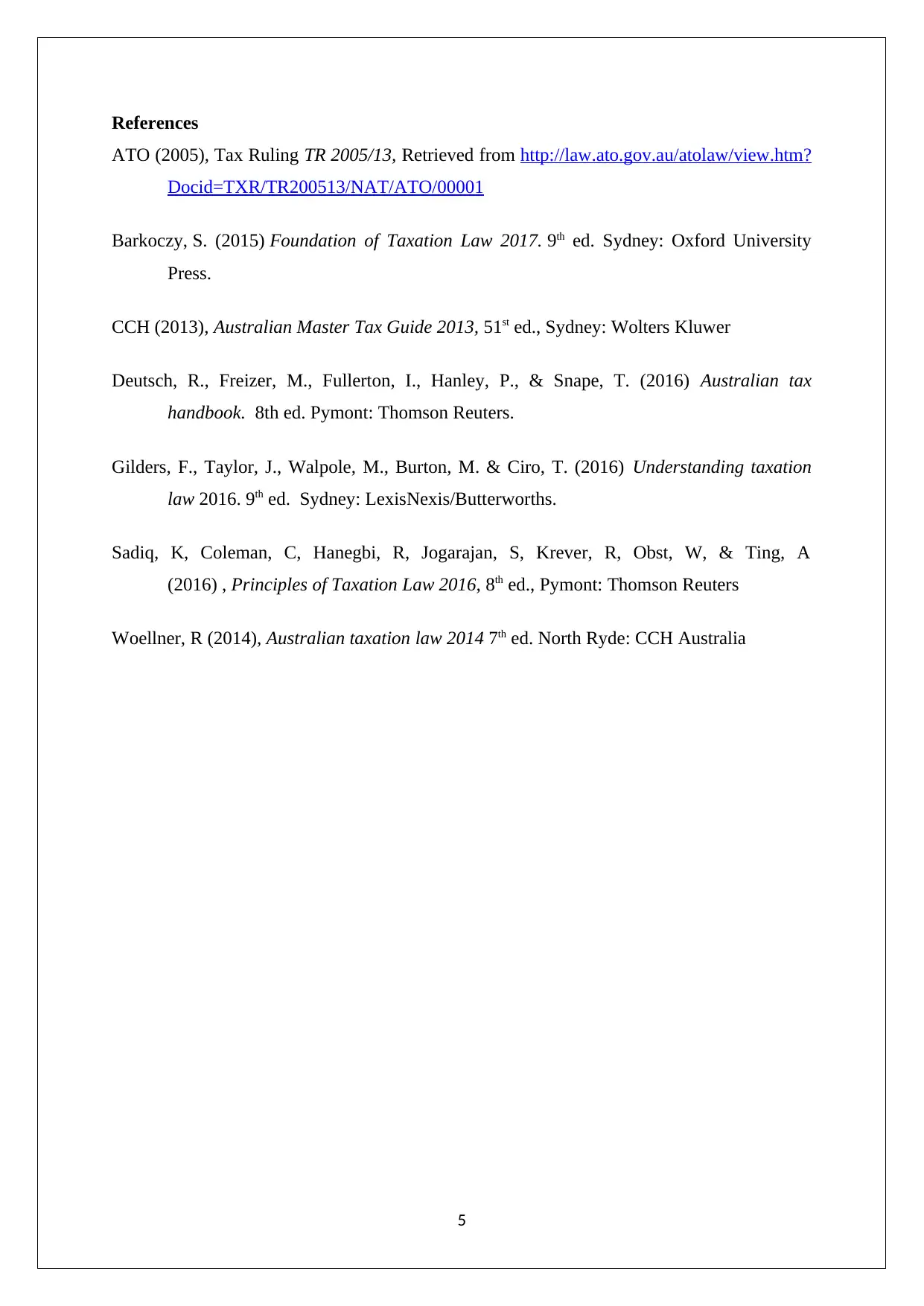
References
ATO (2005), Tax Ruling TR 2005/13, Retrieved from http://law.ato.gov.au/atolaw/view.htm?
Docid=TXR/TR200513/NAT/ATO/00001
Barkoczy, S. (2015) Foundation of Taxation Law 2017. 9th ed. Sydney: Oxford University
Press.
CCH (2013), Australian Master Tax Guide 2013, 51st ed., Sydney: Wolters Kluwer
Deutsch, R., Freizer, M., Fullerton, I., Hanley, P., & Snape, T. (2016) Australian tax
handbook. 8th ed. Pymont: Thomson Reuters.
Gilders, F., Taylor, J., Walpole, M., Burton, M. & Ciro, T. (2016) Understanding taxation
law 2016. 9th ed. Sydney: LexisNexis/Butterworths.
Sadiq, K, Coleman, C, Hanegbi, R, Jogarajan, S, Krever, R, Obst, W, & Ting, A
(2016) , Principles of Taxation Law 2016, 8th ed., Pymont: Thomson Reuters
Woellner, R (2014), Australian taxation law 2014 7th ed. North Ryde: CCH Australia
5
ATO (2005), Tax Ruling TR 2005/13, Retrieved from http://law.ato.gov.au/atolaw/view.htm?
Docid=TXR/TR200513/NAT/ATO/00001
Barkoczy, S. (2015) Foundation of Taxation Law 2017. 9th ed. Sydney: Oxford University
Press.
CCH (2013), Australian Master Tax Guide 2013, 51st ed., Sydney: Wolters Kluwer
Deutsch, R., Freizer, M., Fullerton, I., Hanley, P., & Snape, T. (2016) Australian tax
handbook. 8th ed. Pymont: Thomson Reuters.
Gilders, F., Taylor, J., Walpole, M., Burton, M. & Ciro, T. (2016) Understanding taxation
law 2016. 9th ed. Sydney: LexisNexis/Butterworths.
Sadiq, K, Coleman, C, Hanegbi, R, Jogarajan, S, Krever, R, Obst, W, & Ting, A
(2016) , Principles of Taxation Law 2016, 8th ed., Pymont: Thomson Reuters
Woellner, R (2014), Australian taxation law 2014 7th ed. North Ryde: CCH Australia
5
⊘ This is a preview!⊘
Do you want full access?
Subscribe today to unlock all pages.

Trusted by 1+ million students worldwide
1 out of 6
Related Documents
Your All-in-One AI-Powered Toolkit for Academic Success.
+13062052269
info@desklib.com
Available 24*7 on WhatsApp / Email
![[object Object]](/_next/static/media/star-bottom.7253800d.svg)
Unlock your academic potential
Copyright © 2020–2025 A2Z Services. All Rights Reserved. Developed and managed by ZUCOL.




